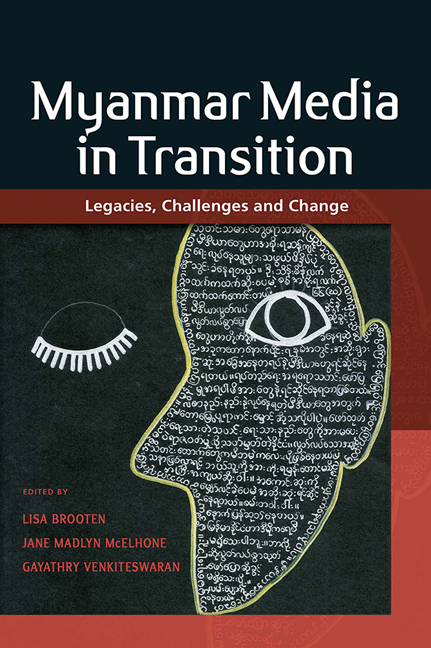Book contents
- Frontmatter
- Contents
- Contributors and Editors
- Burma or Myanmar? A Note on Terminology
- 1 Introduction: Myanmar Media Historically and the Challenges of Transition
- Part I Structural Constraints and Opportunities
- Part II Journalism in Transition
- Part III Creative Expression
- 14 Myanmar's Pop Music Industry in Transition
- 15 New Video Generation: The Myanmar Motion Picture Industry in 2017
- 16 Films for Dignity
- 17 A “Fierce” Fear: Literature and Loathing after the Junta
- Part IV Society and Media
- Epilogue: Media Studies in Myanmar – Where Do We Go from Here?
- Index
15 - New Video Generation: The Myanmar Motion Picture Industry in 2017
from Part III - Creative Expression
Published online by Cambridge University Press: 07 September 2019
- Frontmatter
- Contents
- Contributors and Editors
- Burma or Myanmar? A Note on Terminology
- 1 Introduction: Myanmar Media Historically and the Challenges of Transition
- Part I Structural Constraints and Opportunities
- Part II Journalism in Transition
- Part III Creative Expression
- 14 Myanmar's Pop Music Industry in Transition
- 15 New Video Generation: The Myanmar Motion Picture Industry in 2017
- 16 Films for Dignity
- 17 A “Fierce” Fear: Literature and Loathing after the Junta
- Part IV Society and Media
- Epilogue: Media Studies in Myanmar – Where Do We Go from Here?
- Index
Summary
We need more films about strong topics, such as about violence against women.… If I make a film like that, I will not portray women as victims only. Some women are powerful, brave to speak up. Other women can learn from those women and that can be empowering for them.
—Hnin Ei Hlaing, independent filmmakerLocal filmmaking has played a crucial role in Burmese society since the first Burmese feature film hit the silver screen in 1920. Even during the decades of supposed economic stagnation and political isolation, Burmese film studios continued to produce feature-length movies that entertained audiences in the hundreds of cinemas throughout the country. Numerous black and white Burmese motion picture classics continue to be shown on Myanmar television, and, from the 1990s, aspiring filmmakers have increasingly made use of digital production and distribution. With changing technologies, the establishment of the Yangon Film School and the momentum of international film festivals, a new generation of filmmakers in Myanmar have been using film to point to formerly taboo topics, and they have been engaging film communities in the international arena with their works.
In a context in which creative expression inside the country was heavily stifled by a stringent government censor board, what happens when international filmmakers and political documentarians are suddenly allowed to mix with local filmmakers? How has the atmosphere changed for the motion picture industry during the political transition of this decade? In her book on political transition and Brazilian women's filmmaking, Leslie Marsh observed that political aperturism in the country coincided with technological advances in film and video, which set the ground for greater alternative video production (Marsh 2013, p. 32). Although Marsh's study coincided with the transition in video production from celluloid to video, we can also consider the ways in which entirely digital video production, and even smartphone video cameras, have affected the ways in which people document social worlds and produce and distribute motion pictures about them.
Following a summary of secondary and primary sources on the subject of film production in Burma, I will present an overview of the history of the Burmese film industry, from the British colonial period, to independence, to the years of the Burmese Socialist Program Party, and then the SLORC/SPDC years of strict censorship.
- Type
- Chapter
- Information
- Myanmar Media in TransitionLegacies, Challenges and Change, pp. 287 - 306Publisher: ISEAS–Yusof Ishak InstitutePrint publication year: 2019

